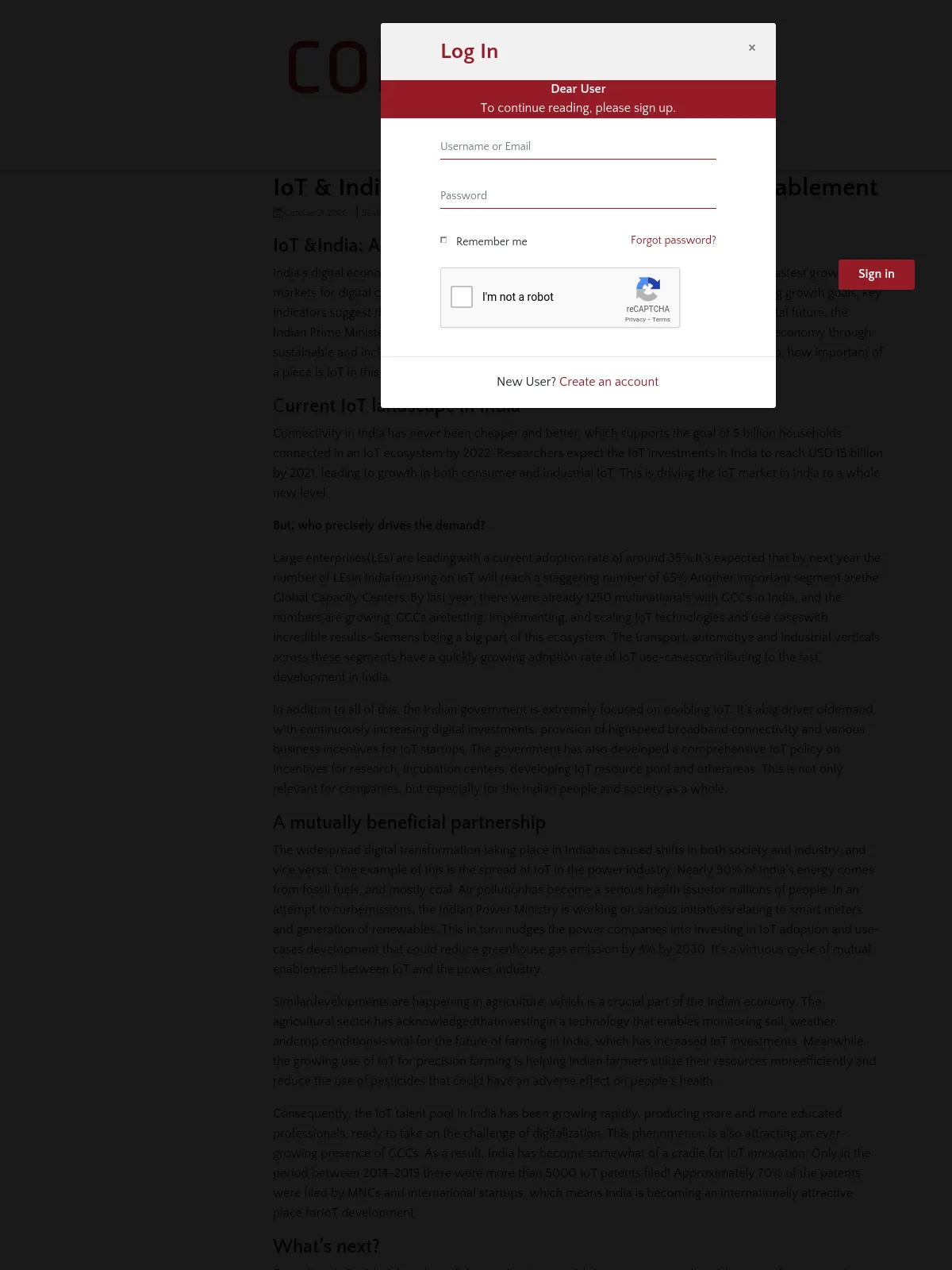IoT & India: A Story of Synergy and Mutual Enablement
Blog: NASSCOM Official Blog
IoT &India: A Story of Synergy and Mutual Enablement
India’s digital economy surpasses thoseof most other countriesbeing one of the largest and fastest growing markets for digital consumers. Even though the Covid-19 pandemic has an impact onreaching growth goals, key indicators suggest that the Indian economy is picking up. Accompanied by big plans of a digital future, the Indian Prime Minister Mr. Narendra Modiannounced India’s vision for 2025 –a USD 5 trillion economy through sustainable and inclusive development, at the center of which are key digital technologies. So, how important of a piece is IoT in this puzzle?
Current IoT landscape in India
Connectivity in India has never been cheaper and better, which supports the goal of 5 billion households connected in an IoT ecosystem by 2022. Researchers expect the IoT investments in India to reach USD 15 billion by 2021, leading to growth in both consumer and industrial IoT. This is driving the IoT market in India to a whole new level.
But, who precisely drives the demand?
Large enterprises(LEs) are leadingwith a current adoption rate of around 35%.It’s expected that by next year the number of LEsin Indiafocusing on IoT will reach a staggering number of 65%.Another important segment arethe Global Capacity Centers. By last year, there were already 1250 multinationals with GCCs in India, and the numbers are growing. GCCs aretesting, implementing, and scaling IoT technologies and use caseswith incredible results–Siemens being a big part of this ecosystem. The transport, automotive and industrial verticals across these segments have a quickly growing adoption rate of IoT use-casescontributing to the fast development in India.
In addition to all of this, the Indian government is extremely focused on enabling IoT. It’s abig driver ofdemand, with continuously increasing digital investments, provision of highspeed broadband connectivity and various business incentives for IoT startups. The government has also developed a comprehensive IoT policy on incentives for research, incubation centers, developing IoT resource pool and otherareas. This is not only relevant for companies, but especially for the Indian people and society as a whole.
A mutually beneficial partnership
The widespread digital transformation taking place in Indiahas caused shifts in both society and industry, and vice versa. One example of this is the spread of IoT in the power industry. Nearly 90% of India’s energy comes from fossil fuels, and mostly coal. Air pollutionhas become a serious health issuefor millions of people. In an attempt to curbemissions, the Indian Power Ministry is working on various initiativesrelating to smart meters and generation of renewables. This in turn nudges the power companies into investing in IoT adoption and use-cases development that could reduce greenhouse gas emission by 4% by 2030. It’s a virtuous cycle of mutual enablement between IoT and the power industry.
Similardevelopments are happening in agriculture, which is a crucial part of the Indian economy. The agricultural sector has acknowledgedthatinvestingin a technology that enables monitoring soil, weather, andcrop conditionsis vital for the future of farming in India, which has increased IoT investments. Meanwhile, the growing use of IoT for precision farming is helping Indian farmers utilize their resources moreefficiently and reduce the use of pesticides that could have an adverse effect on people’s health.
Consequently, the IoT talent pool in India has been growing rapidly, producing more and more educated professionals, ready to take on the challenge of digitalization. This phenomenon is also attracting an ever-growing presence of GCCs. As a result, India has become somewhat of a cradle for IoT innovation. Only in the period between 2014-2019 there were more than 5000 IoT patents filed! Approximately 70% of the patents were filed by MNCs and international startups, which means India is becoming an internationally attractive place forIoT development.
What’s next?
Even though Covid-19 has slowed down adoption rate, it’s important to see the wide range of opportunities. Investing in key technologies that are likely to grow in the future during downturns can make all the difference.
Regardless of the current situation, it’s more than clear that IoT technologies and India have a synergic relationship. IoT is bettering the lives of millions of Indians and creating an impact on their economy, while India is enabling an environment in which IoT innovation is encouraged and thrives.
Author’s Full Name & Designation
Pankaj Vyas
CEO & Managing Director, Siemens Technology and Services Pvt. Ltd.
Social media handle of the Author: https://www.linkedin.com/in/pankajnvyas?lipi=urn%3Ali%3Apage%3Ad_flagship3_profile_view_base_contact_details%3BGhEWKJLASUG2eyo9tfMKlQ%3D%3D
The post IoT & India: A Story of Synergy and Mutual Enablement appeared first on NASSCOM Community |The Official Community of Indian IT Industry.
